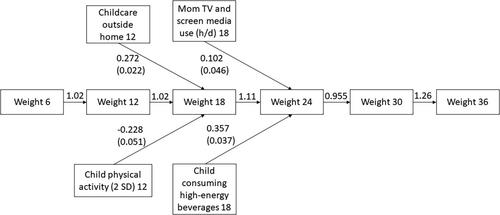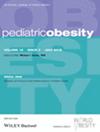Child and mother characteristics associated with 6-month weight gain for infants and toddlers during 6 to 36 months
Abstract
Background
The prevalence of childhood obesity in the U.S. has increased, likely due to decreased physical activity, increased sedentary behaviour and unhealthy diets. Little is known about the relationships between these factors and weight gain in those under the age of three.
Objectives
This study aimed to understand the longitudinal associations of weight gain over 6-month intervals with child and parent characteristics as children develop from 6 to 36 months.
Methods
Mother and infant data were collected at 6-month intervals from 6 to 36 months. Weight (kg) was the primary outcome variable, and potential explanatory variables included child and parent characteristics, physical activity, motor development, diet and sleep. Structural equation modelling was used to assess associations between explanatory variables and 6-month weight gain.
Results
Weight increased ~1 kg per 6-month interval (p < 0.001) from 6 to 36 months. Childcare outside of the home at 12 months was associated with 0.272 kg (p = 0.002) greater weight gain at 18 months, while children's physical activity was associated with 0.228 kg (per 2 SD, p = 0.051) less weight gain during the same time period. Mother's TV and screen media use (0.102 kg per hour/day, p = 0.046) and child's intake of high-energy beverages at 18 months (0.387 kg, p = 0.037) were both associated with greater weight gain at 24 months.
Conclusion
Childcare, physical activity, screen media use and high-energy beverage consumption might affect weight gain at different time points in early childhood. These insights can inform efforts to prevent excessive weight gain and childhood obesity effectively.


 求助内容:
求助内容: 应助结果提醒方式:
应助结果提醒方式:


